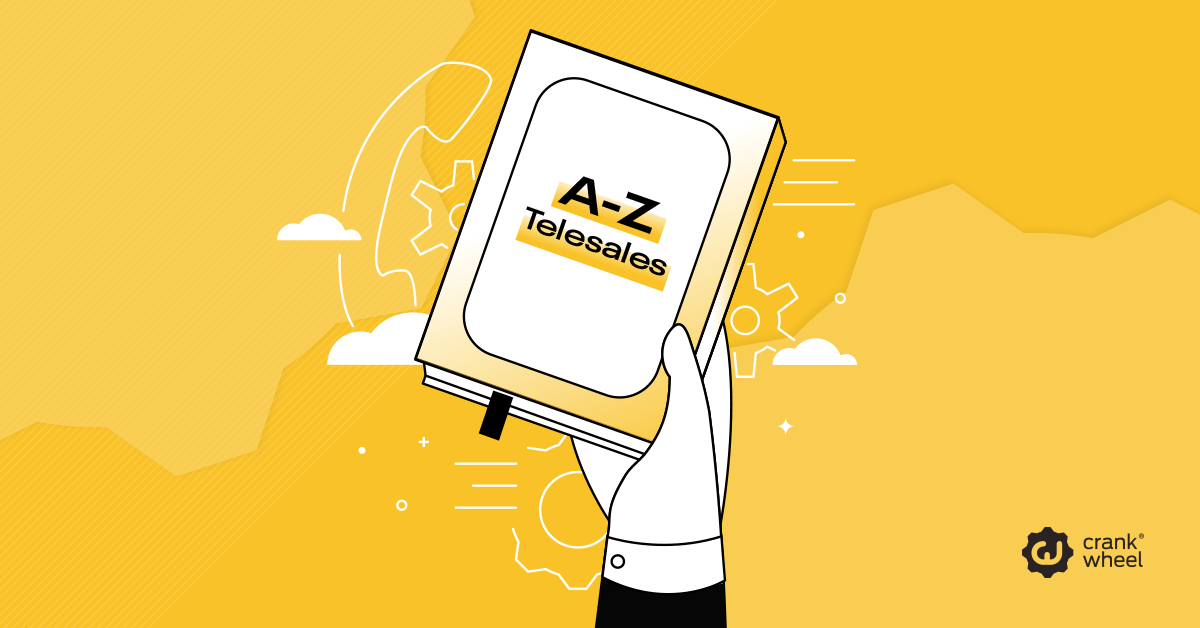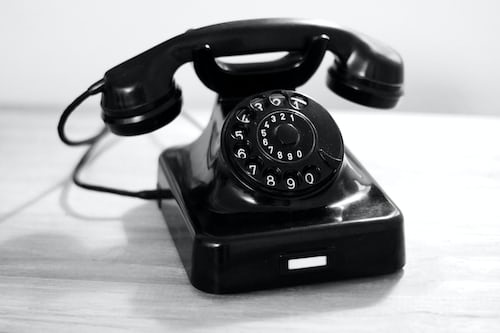The A-Z of Telesales
The very nature of how business is conducted has dramatically changed in the past few years. More and more things have started to migrate online, and daily habits have started to reflect this.

The strategies that companies use to engage with potential clients, service existing ones and search for new leads have all seen some major shifts, but one of the most effective ways to generate business and close sales continues to be telesales.
In the world of telesales and remote selling, it’s important to find ways to be set apart from ‘annoying telemarketers’ or ‘spam callers’, yet many in the industry still stick to old-fashioned methods, outdated lists and poor sales scripts that don’t really do anything to show potential leads that this particular call will be any different.
Although telesales is a $500 billion-dollar-a-year business, consumers are still robbed of over $40 million every year in fraudulent telemarketing scams, so it stands to reason that putting your best foot forward isn’t just important for establishing trust; it’s essential.
When used effectively, the best telesales practices consistently show that they yield great results. Whether you’re a brand-new remote seller or an experienced telesales veteran, selling to customers over the phone is no easy feat
With so many things to consider, like developing relationships, understanding products and services, and building customer credibility, it’s hard to know where to start!
That’s why we created this A-Z guide for successful telesales; essential tips from experts in the industry that will help you develop your skills and hone your approaches for better results.
So whether you’re just starting out or want a refresher on strategies for success, read on and get ready to up your telesales game.
Shortcuts:
- A: An Authoritative Tone
- B: B2B vs B2C Mindsets
- C: Communication & CRM Systems
- D: Differentiate Customers
- E: Exercise Tailored Scripts
- F: Focus on the Customer’s Needs
- G: Generate Leads
- H: Help Customers Learn
- I: Introduce Up-Selling
- J: Journey Development
- K: (Leverage) Knowledge of Customers
- L: Learn About Your Customers
- M: Manage Expectations
- N: Keep things Natural
- O: Organize Everything
- P: Professional Pitches
- Q: Qualify Your Leads
- R: Regularly Re-engage Leads
- S: Structure Sales Calls
- T: Time Your Call
- U: Unique Selling Points
- V: Versatility in Selling
- W: Warm Calling
- X: eXceptional Closing Lines
- Y: Year-End Reporting and Analysis
- Z: Zealous Enthusiasm in Communication
A. An Authoritative Tone

Selling remotely requires a delicate balancing act between being helpful and authoritative. It is essential to demonstrate that you are the expert in your field while remaining friendly, casual and conversational with your clients.
The key to maintaining an authoritative tone is to focus on results and outcomes by emphasizing the value being offered to the prospect.
This can be achieved through straightforward language delivered in a confident and matter-of-fact way which shows potential buyers that you’re in control of the process but still happy to help them achieve their goals.
An effective remote seller understands how vital it is to have an authoritative tone throughout every interaction in order to achieve success.
B. B2B vs B2C Mindsets

There are differences between B2B and B2C sales, so the mindset of the salesperson needs to be adjusted depending on which particular sales relationship they are engaged in.
When selling to businesses, it’s important to understand the business needs and priorities of prospects.
Setting yourself apart from other remote sellers by having a deeper understanding of different businesses is key. Crafting tailored solutions that meet their specific goals takes dedication and effort but will ultimately lead to higher success rates.
On the other hand, when selling directly to customers, connecting on an emotional level can be really effective by playing off the desires and lifestyle of your target audience. Doing this well requires taking the time to get inside their heads in order to make those connections.
To set them apart in a more simplistic way, think of B2B sales as being driven by logic, whereas B2C sales tend to be more led by emotion. Understanding B2B and B2C mindsets is essential to becoming a successful remote seller.
C. Communication & CRM Systems

It’s important to stay connected with your clients when you’re a remote seller, so having a reliable communication system is essential.
Utilising CRM (Customer Relationship Management) software to keep track of your conversations and all customer interactions can be incredibly helpful. With the right organization, CRM systems will help you remain professional and on top of all details that might arise in sales calls or emails.
Additionally, these systems can provide helpful insights about each customer that can be used to personalize conversations and create positive experiences for them.
All in all, an effective CRM system should allow you to have organized, conversational contact with every client, regardless of their location.
D. Differentiate Customers
Differentiating customers is essential when it comes to becoming an effective remote seller. By taking the time to understand each customer’s specific needs and interests, you can tailor your sales approach accordingly.
After all, it’s not a one-size-fits-all solution when it comes to selling remotely! It’s important to take the time to research and really get to know your customers so that you can provide them with the best service possible.
Many CRM systems allow salespeople to collect notes on their clients that might not necessarily be important metrics for the sales process.
This kind of information might not be helpful in a data set, but it does help to show leads that you listen to them and at least seem to remember things they have told you.
For example, if a lead mentions they are about to go on vacation in a previous phone call, asking them how their vacation was in the next call can go a long way towards instilling trust and making the lead feel like the salesperson will treat them with individual care and support.
It also helps to demonstrate that as a salesperson, you value their opinions and input, and this will, in turn, lead to a more successful sales experience for all parties.
E. Exercise Tailored Scripts

When selling remotely, it’s important to not assume that the same tactic will work with each lead, and your approach should reflect this.
To be effective in this kind of situation, you must learn the art of developing tailored sales scripts for different scenarios which allow for the customization of key messaging points.
A variety of sales scripts can be developed depending on the different kinds of leads, products, services, and pain points; almost any element of the process could be given individual attention.
Exercise and practice your scripts with peers so that when the time comes to interact with customers, you’re prepared and confident and able to present ideas in a way that resonates with them. These sales scripts can also include things like FAQs or potential reasons why a lead might hesitate to convert.
With a little extra effort and preparation ahead of time, using custom scripts can help make a more impactful impression on potential new customers than using the same template for each one.
F. Focus on the Customer’s Needs
To get the most out of the sales process, it is of utmost importance to establish a laser focus on the needs of your customer.
Being aware of their interests and desires allows you to hone in on messaging that speaks directly to them.
This strengthens your relationship with the customer and ultimately leads to successful sales. Studies have shown that both profit and customer retention are positively impacted by a more customer-centric sales approach.
Additionally, take the time to review purchasing history and needs past, present, and future. This helps you better understand their journey, ensuring that you have all the information needed to meet their requirements.
G. Generate Leads
 Knowing how to generate leads in sales is an important element of being a successful remote seller. It can be daunting at first, but there are many effective strategies you can use to get your name out in the marketplace.
Knowing how to generate leads in sales is an important element of being a successful remote seller. It can be daunting at first, but there are many effective strategies you can use to get your name out in the marketplace.
A good place to start is by strategic networking with people who may have similar customer bases, advertising online, generating leads on social media or reaching out directly to the companies you want to work with.
Remaining organized and consistent with your outreach will ensure you have a steady stream of leads flowing in. Investing time into lead generation early in the process pays off in the long run. Effective lead generation can eventually become a self-sustaining part of the sales business, but it takes time and energy to set up and foster.
H. Help Customers Learn
The best salespeople know that they tend to have more success when they approach a sale from the perspective of trying to ensure a lead has a solid understanding of what particular products or services will help with their particular problems and why. Taking the educational element a step further can provide even more desirable outcomes.
Offering resources that provide assistance, such as tutorials, instructional videos, instruction manuals and more, is a great way to ensure customers are able to make use of products and services in the most advantageous manner possible.
Additionally, remote sellers should also be available to answer customer questions along the way and take advantage of helpful feedback from customers in order to make sure their products or services meet even their most exacting needs.
Helping customers learn not only drives sales but allows for increased customer satisfaction and creates trustworthy relationships for ongoing success.
I. Introduce Up-Selling
With the rise of remote sales, learning how to upsell can be critical to success. Up-selling involves developing relationships and learning how to demonstrate the additional value a product or service can bring to a customer’s purchasing experience.
Up-selling doesn’t have to feel like pushing something onto a customer. Instead, the goal is to genuinely work with your customers and help them find the products and services that are best suited to their needs. So focus on building trust with transparency, provide value in up-sell conversations, and strive for helpfulness so that customers come away feeling fulfilled and ready for what comes next.
J. Journey Development
Developing a customer journey map is key to becoming an effective salesperson in any industry. Taking the time to build out your customer’s journey helps you understand the sequence of events that occur between the first contact and sale and how they are feeling each step of the way.
Through this exercise, you will be able to better tailor experiences, plan your outreach efforts, and recognize opportunities for growth.
Understanding the entire sales cycle means having the ability to recognize individual touchpoints within a sale and identify where sales can be improved. Utilizing journey development for tracking leads, closing deals more efficiently, and providing better customer service are all invaluable skills that will help to yield better sales results.
K. (Leverage) Knowledge of Customers

Knowing your customer’s preferences, needs, and interests can be invaluable in the sales game. A great way to stay informed about your customers is to leverage the power of technology and use a CRM system to save customer data.
By actively tracking customer interactions, from the first contact to current purchases and potential leads, you can quickly find opportunities for upselling or creating targeted campaigns that address the wants and needs of your customers.
With this information in your hands, you’ll be in a better position to close deals more efficiently with valuable insights into what works best for each customer. Taking the time to understand who your customers are can almost help you to know what they want before they do.
L. Learn About Your Customers
Learning about your customers is one of the most important (but often overlooked) aspects of working in sales.
It has been mentioned earlier that collating information about their purchase history, pain points and other elements of the sales journey is important, but truly getting to know who they are will set you apart from any other salesperson that comes into their orbit.
Keep detailed notes on each customer so that you understand the details of the account and provide solutions quickly.
Additionally, try to go beyond just understanding their products, services, or account needs; try to uncover what keeps them up at night and how you may be able to help with those struggles. In doing so, you’ll become a trusted partner, and they will see you as an invaluable asset even though you’re not in front of them every day.
M. Manage Expectations
It’s crucial when working in telesales to make sure all parties understand their commitments and expectations with each other. Before starting each working relationship, lay out what you expect from the client and what they can expect from you.
This should include things like deadlines, deliverables, payment terms, communication platforms, and terms and conditions. Make sure that everyone is aware of those key elements and how they will or could potentially affect things.
Establishing a clear path to success upfront can help to prevent any conflicts before they have a chance to start.
Ensuring that everyone is on the same page can also set up a strong foundation for building successful relationships with customers in the remote selling space moving forward.
Welcome to part two of our A to Z guide to telesales! In part one, we covered topics from A to M. Now, let’s dive into the rest of the alphabet as we explore tips and approaches for successful telesales.
N. Keep things Natural
One of the keys to success in telesales is to keep things natural. Avoid rigid scripts and pushy tactics that can put off your customers.
Instead, have a conversation with them and get to know their needs, interests, and pain points.
The power of rapport is often overlooked in telesales, particularly when we’re often instructed to ‘stick to the game plan’, but the benefits of building a personal connection with prospects is multifaceted.
Speaking to people like humans through active listening and understanding interests, pain points, likes and dislikes, helps to build stronger relationships, and support successful sales conversions.
O. Organize Everything
Organization is key when it comes to telesales. This includes your pitch, your approach, your processes, and your customer understanding.
When you’re organized, you can be much more effective in your sales conversations and better able to meet the needs of your customers.
It’s often the case in any kind of sales encounter, where agents are quick to simply wing the situation, make assumptions, and not have a game plan.
The importance of setting an agenda, delivering a clear pitch, and creating concrete calls to action can not be underestimated when focusing on growing sales.

P. Professional Pitches
Making a good impression is crucial in telesales, and that starts with your pitch. Having a well-crafted and professional pitch can help you build trust and establish credibility with your prospects.
Take the time to refine your pitch and make sure it’s effective in communicating the value of what you’re selling.
Tailoring the pitch to each customer is also beneficial.
By not simply delivering the same sales pitch as a one-size-fits-all solution for every customer, you’re taking that extra level of care to understand their needs and wants, their business, and how your products or services can help them.
Professionalizing the structure, design, and tailoring the solution will help you to deliver more success in telesales.

Q. Qualify Your Leads
Not every lead will be a good fit for your product or service. Qualifying your leads by asking the right questions and understanding their needs and budget can help you focus your efforts on the most promising prospects.
This ensures you’re not wasting your time on leads that are unlikely to convert.
Think of it this way, without accurately qualifying and scoring a lead you would likely end up spending as much time on a lucrative game-changing deal as you would to a much smaller peripheral prospect.
With effective lead qualification, you can more efficiently target your sales efforts.

R. Regularly Re-engage Leads
Just because a lead didn’t convert the first time doesn’t mean they won’t be interested in the future.
Following up with leads regularly and continuing to provide them with value can help you re-engage them and increase your chances of conversion over time.
Leads regularly go cold. But, with modern options of structuring task setting, as well as the added benefits of CRM email automation, re-engaging any lead should become much simpler, faster, and more robust across your internal processes.
Every re-engagement increases your chances of sales success.
S. Structure Sales Calls
When it comes to sales calls, having a clear structure can help you stay on track and make the most of your time.
Plan out your approach ahead of time and make sure you’re addressing all the key points that are relevant to your prospect.
For instance, it’s important to set an agenda, deliver your pitch, be clear on desired calls to action, and leave enough time for questions.
This creates a more professional and reliable sales encounter and increases the likelihood of conversions.
T. Time Your Call
In most aspects of life timing is key, and telesales is no different. Your primary objective is to serve the customer, cater to their schedules, and approach them at the right time in their business cycle.
Without sufficient understanding of the most appropriate timings to your customer, you could inadvertently miss an opportunity.
With timing comes patience, and patience with customers in telesales is essential to delivering a successful outcome.
For instance, if you’re calling someone at an unscheduled time or corresponding with prospects during their quarter-end, you could miss out on an opportunity.

U. Unique Selling Points
Your unique selling point (USP) is what sets your product or service apart from the competition.
It’s important to teach your customers about your USP and show them why it’s valuable to them. This can help you differentiate yourself in a crowded market and win over more customers.
In telesales, it’s essential to understand and communicate your unique selling points clearly.
Identifying and highlighting what makes your product or service unique helps you stand out from the competition and capture the attention of your prospects.
V. Versatility in Selling
Different situations require different approaches, so versatility is key in telesales. Being able to adapt your approach to suit different prospects and situations can help you build stronger relationships and close more deals.
It’s not enough to simply try once with a prospect, but instead show clear determination to engage, re-engage, educate, and re-educate on your offerings.
Now, we’re not telling you to harass every prospect that comes your way and bombard them with endless marketing communications - instead, read the room, leverage your understanding of each qualified lead and act accordingly, but don’t give up!
W. Warm Calling
Warm calling refers to calling prospects who have already expressed interest in your product or service.
This can be a much more effective approach than cold calling because the prospect is already somewhat familiar with what you have to offer.
Following up on a warm call is much more impactful to your sales performance than following up on a cold call.
It’s a simple fact that selling to engaged prospects who show a genuine interest in your offering has a greater likelihood of delivering sales results for your company.
X. eXceptional Closing Lines
Having a strong closing line is crucial to sealing the deal in telesales. A great closing line can leave a lasting impression on your prospects and help them feel confident in taking the next step.
Put some thought into crafting exceptional closing lines that are effective in converting leads into customers.
When we think of ‘closing’ it’s usually centered on the art of closing the deal.
But, when it comes to closing lines it’s important to summarise your pitch and provide clear and actionable calls to action.
This allows the prospect to know what is expected as part of the next step in the sales process and clearly defines requirements.

Y. Year-End Reporting and Analysis
End-of-year reporting and analysis is an important part of any telesales strategy.
It helps you assess your performance, identify areas for improvement, and make adjustments to your approach going forward. Take the time to review your results at the end of each year to ensure you’re on track to reach your goals.
Analyzing data can seem like a tedious task, especially when you want to focus your energy on sales, but regular data assessments help you in the long run to take key learnings and refine your approach.
Nobody goes into telesales with the Holy Grail of success, and it’s important to be humble and acknowledge where things have gone wrong, as well as take pride in the successes where things have gone right.
Z. Zealous Enthusiasm in Communication
Finally, zealous enthusiasm in communication can be contagious when it comes to telesales. When you’re excited about what you’re selling, it shows in your voice and your approach.
This can help build trust and enthusiasm in your prospects, leading to more successful sales conversations.
After all, we all want to buy from people with passion and pride in what they do. It builds greater connections, supports trust-building, and advances chances of success.
We can all remember a sales encounter from the past speaking to someone with no enthusiasm as a genuine clock-watcher ticking down the time to closing time. Take pride and be zealous with every prospect you speak to.
Conclusion

Selling remotely is a great way to ensure success in today’s ever-evolving market, but it requires a lot of knowledge and understanding to effectively maximize results.
Becoming an expert in telesales can take time, but the tips provided within this blog are essential building blocks for getting started.
